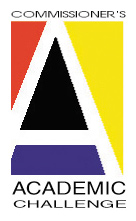|
The Commissioner's Academic Challenge |
|
 |
The Commissioner's Academic Challenge is recognized by both the Florida Department of Education and the Florida High School Athletics Association (FHSAA) [Though to look at their web site you'd never know it] as the academic state championship for the state of Florida. |
| The Commissioner's Academic Challenge groups the 67 districts of Florida into three divisions, from Division III, the small rural districts to Division I, the large metropolitan districts. Each Division has four competitive rounds. in the 1st round, the best of the best advance directly to the semi-finals. The rest go into a consolation round and the best of those then also move to the semi-finals. The best in each of the semi-finals move to the 6-team final. The winner of that match is crowned state champion. | |
| Each round is a combination of quick-response "button questions" mixed with more in-depth-thinking team questions. A team is four high school students. They have one response button on the table and they respond as a team. Each round is from three to six teams, with one button each. Each team starts with 100 points. If a team "buys" a button question and gets it right, they earn the value of the question. But if they get it wrong, the value of the question is deducted. We start with 20 5-point button questions. This is followed by a ten-point team question. The team question is a multi-item question where points can only be gained, not lost. Following a short break, there are 20 10-point button questions and then a twenty-point team question. Finally, after another break, there are 25 15-point button questions. These can be very valuable, or very costly. A right answer earns 15 points, but a wrong answer costs 15 points. So, if a team is trying to gain or protect a lead, each question answered is, in reality, worth 30 points! This is followed by a thirty point team question. The whole round runs from an hour and 20 minutes to two hours, depending on challenges. | |
| Challenges: The staff tries to avoid challenges through being prepared. The day before competition starts, the senior staff engages in an activity called "The Dreaded Day." Since the total tournament consists of 8 rounds and the questions are different in each round, that means....520 button questions. With three team questions in each round, that's 24 team questions. The Dreaded Day bears its name because the staff spends the entire day reading and discussing every single question, along with every conceivable answer a contestant might utter. We carefully check the pronunciation of every term and every historical person's name (though most of them are dead and wouldn't be offended if the name was mis-pronounced.) | |
| The Venue: The Commissioner's Academic Challenge is held in the convention center adjacent to the Contemporary Resort at Walt Disney World. This alone makes the tournament an enticing destination. Included in registration is a three-day park-hopper pass to the four Disney Parks. While this makes the tournament look like a vacation, I, myself, spent 1.5 hours in EPCOT and still have two days left on the ticket. Alas, as a tournament ticket, those unused days will expire at the end of the month. | |
| This is a very rewarding experience and I have been honored to do it for 11 years, half of the life-time of the tournament. Some of my colleagues think it a vacation, what with it being at Disney and all. But it is an exhausting, if pleasant experience. I'm indebted to Peggy Harrod, Tournament Director, for allowing me to come. In June, I'll write about the Panasonic Academic Challenge. | |
